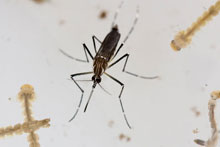The mosquitoes that spread dengue fever tap into the domestic networks of humans, along with their bloodstreams, finds a study recently published in the Proceedings of the National Academy of Sciences (PNAS).

Like the housefly, the Aedes aegypti mosquito that spreads the dengue virus is a homebody, perfectly adapted to the domestic life of humans.
The data from Iquitos, Peru, shows that the trail of the most rapid transmission of human infections does not lead through large, public gathering places, as might be expected, but from house-to-house, as people visit nearby friends and relatives.
"It's common in a dengue fever outbreak to first treat public places like schools for mosquitoes, but our results show the focus needs to be on residential networks," says disease ecologist Gonzalo Vazquez-Prokopec.
Vazquez-Prokopec and Uriel Kitron, both from Emory University's department of environmental studies, conducted the spatial-temporal analysis as co-authors of the study, led by Steve Stoddard and Thomas Scott from the University of California, Davis. The research is part of a major, ongoing dengue project that also includes scientists from the U.S. Navy; the University of Iowa; Tulane University; San Diego State; and researchers in Peru.
"On a global scale, human air travel is known as a driver of dengue virus circulation, but this is the first time we've quantified the powerful impact of human movement on the small scale of neighborhoods," Vazquez-Prokopec says.
The tropical disease is caused by a virus that is passed from the blood of one person to another through the bites of mosquitoes. Also known as "break-bone fever," dengue causes debilitating pain leading to the hospitalization of many sufferers. Severe cases can be fatal.
"It is vicious, and rapidly growing as a threat," Vazquez-Prokopec says.
During the last 50 years, the incidence of dengue has increased 30-fold and more than half the world’s population is now at risk. The World Health Organization estimates that 50-100 million dengue infections occur each year. That number is expected to rise as the climate warms and the trend toward urbanization continues.
During 2009 and 2010, dengue fever emerged for the first time in decades in the contiguous United States, when an outbreak in the Florida Keys led to 93 cases.
